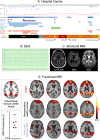Intact Brain Network Function in an Unresponsive Patient with COVID-19
- PMID: 32613682
- PMCID: PMC7361474
- DOI: 10.1002/ana.25838
Intact Brain Network Function in an Unresponsive Patient with COVID-19
Abstract
Many patients with severe coronavirus disease 2019 (COVID-19) remain unresponsive after surviving critical illness. Although several structural brain abnormalities have been described, their impact on brain function and implications for prognosis are unknown. Functional neuroimaging, which has prognostic significance, has yet to be explored in this population. Here we describe a patient with severe COVID-19 who, despite prolonged unresponsiveness and structural brain abnormalities, demonstrated intact functional network connectivity, and weeks later recovered the ability to follow commands. When prognosticating for survivors of severe COVID-19, clinicians should consider that brain networks may remain functionally intact despite structural injury and prolonged unresponsiveness. ANN NEUROL 2020;88:851-854.
© 2020 American Neurological Association.
Conflict of interest statement
Nothing to report.
Figures

References
-
- Norton L, Hutchison RM, Young GB, et al. Disruptions of functional connectivity in the default mode network of comatose patients. Neurology 2012;78:175–181. - PubMed
Publication types
MeSH terms
Grants and funding
- R25 NS065743/NS/NINDS NIH HHS/United States
- K23 NS094538/NS/NINDS NIH HHS/United States
- R21NS109627/NS/NINDS NIH HHS/United States
- RF1NS115268/NS/NINDS NIH HHS/United States
- DP2 HD101400/NH/NIH HHS/United States
- R21AG067562/AG/NIA NIH HHS/United States
- R21 AG067562/AG/NIA NIH HHS/United States
- Tiny Blue Dot Foundation/International
- RF1 NS115268/NS/NINDS NIH HHS/United States
- DP2 HD101400/HD/NICHD NIH HHS/United States
- K23NS094538/NS/NINDS NIH HHS/United States
- James S. McDonnell Foundation/International
- R21 NS109627/NS/NINDS NIH HHS/United States
- R25NS06574309/NS/NINDS NIH HHS/United States
LinkOut - more resources
Full Text Sources
Medical

